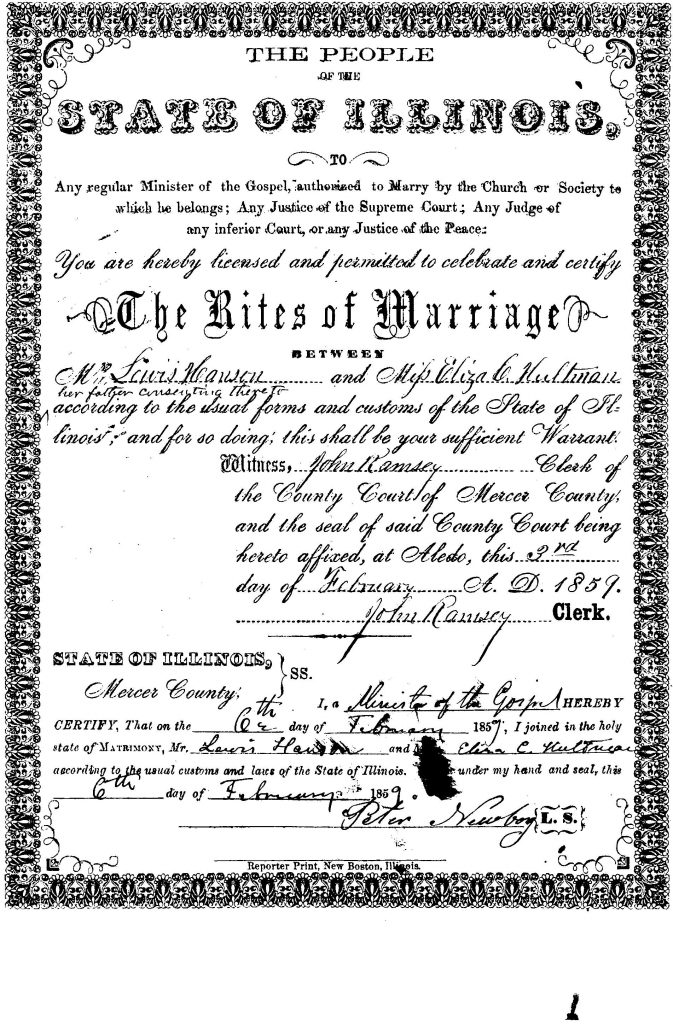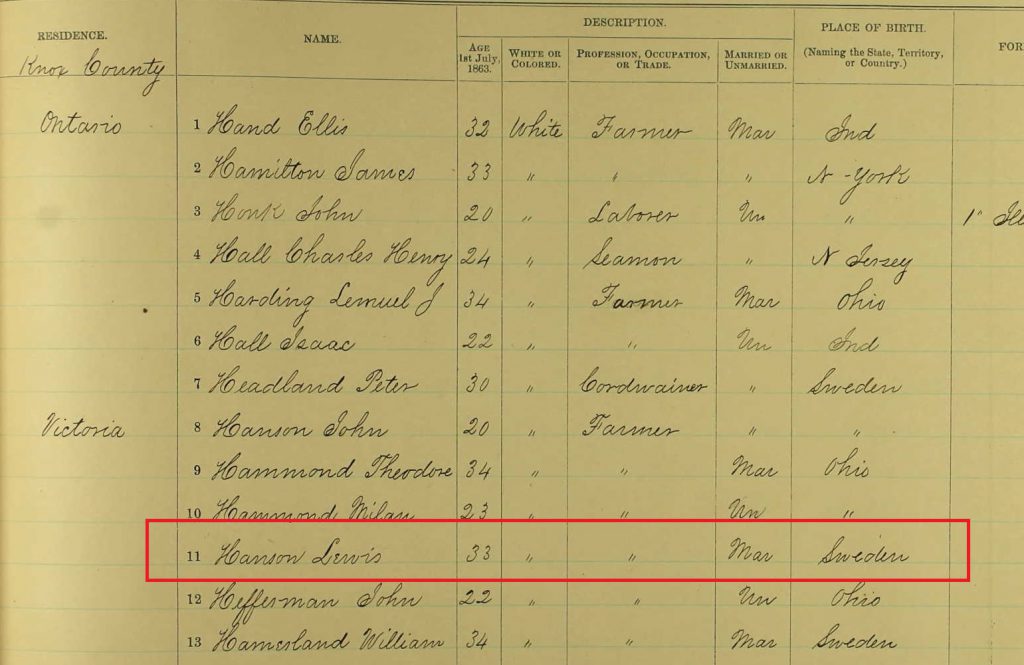Census records show Louis and Lisa Stina comfortably settled in Sparta Township, Knox County Illinois with their infant daughter Emma in 1860. The Civil War started in April 1861 – I wanted to know how the war impacted this young family. Here’s what I found.
First, a short detour to follow up on something from last time. I dug into my digital files and found a copy of their marriage certificate:
A few things to note on this:
- Her name is shown as “Eliza C.”. An Americanized version of Lisa Stina could be “Eliza Christina” and it seems that she was known as Eliza or Elisa for most of her life – even on her tombstone. I’ll continue to refer to her as Lisa Stina just because that’s how our family knows her.
- After her name, it says “her father consenting thereto”. She must have been legally under-age for marriage without consent. Currently in Illinois, you have to be 18 to marry without consent, 16 with consent. Perhaps the law was the same back then, too!
- The certificate is signed by Peter Newborg. I looked him up – he was a Methodist Episcopal minister and assigned at that time in the Methodist’s Illinois Rock Island District to “Swede Mission”. I haven’t been able to determine what “Swede Mission” is (whether it’s a church or a group of churches) so that’s more research to do someday! Anyway, this confirms that Lisa Stina and in particular her father Jonas Peter Hultman were associated with the Swedish Methodist Episcopal church.
Okay, so fast-forward again to the outbreak of the Civil War. The War started in April 1861. Louis and Lisa Stina are on their 80-acre farm near Galesburg and their daughter Emma is eleven months old. Later that year, Lisa Stina is pregnant again and this time with twins. Although of prime age for Cvil War service, Louis does not enlist. A good thing – in June of 1862, Lisa Stina gives birth to twin girls Margaret and Sara. But they survive only three weeks. Having Louis at home was probably life-saving for Lisa Stina.
In 1863, we find Louis on a list of men registered for the draft in Knox County:
The ledger shows him living in Knox County, age 33, occupation “farmer”, married, and born in Sweden (that all checks out perfectly).
From what I can tell, although Louis was registered for the draft, he never served in the Civil War. Either he wasn’t called up, or he bought his way out of service (an accepted practice at the time). Again – a good thing, as Lisa Stina was pregnant again in 1863 and in March of 1864 gave birth to their first son Franklin Solomon Hanson.
After the war, it seems that land prices in Illinois had gotten pretty high. As the population grew and as immigrant children from large families became adults and married, they could not afford to buy land near their parents. Louis and Lisa Stina had a farm, though, but maybe they decided 80 acres wasn’t enough? Or perhaps the soil was rocky or unproductive – who knows. Anyway, they were anxious to look west for better opportunities.
In fact, there were huge numbers of Swedes in Galesburg looking west, and most of them were looking to Kansas. One large group formed the Galesburg Land Company and bought up thousands of acres in McPherson County. They founded the community of Lindsborg, still known today as America’s “Little Sweden”.
The national “Hemlandet” Swedish newspaper published lots of articles about opportunities in Kansas. Louis and Lisa Stina no doubt read about settlement opportunities in the Big Blue Valley near Manhattan, KS:
A correspondent to Hemlandet, Lars Person…wrote from Randolph, Riley County in 1859…”At present we are 8 Swedish and 2 Danish families living here. This place is 110 miles from the Missouri River, situated on both sides of the Big Blue River. The land is so-called “bottom land”, both low and high along the river, mixed with sand. Away from the rim the soil is firm clay loan. The land is laced with many brooks for crystal clear water, guaranteeing a supply of water. Along the shore of the river and the brooks is plenty of woods for building and fencing. Where there is less of woods on the higher places there is fine stone for buildings and fences and enough limestone for processing of lime. Three good markets are less than 30 miles away, namely Manhattan, Fort Riley and Marysville.”*
The war ended in April, 1865 and their next child (my great-grandfather) Edward Cornelius Hanson was born in April, 1866 in Riley County, Kansas. So that means that sometime in that first year after the war ended, they packed up and moved. They didn’t wait for the land companies to get organized, though; they chose a different plan. Louis and Lisa Stina ended up being among the very first homesteaders in the Big Blue River valley.
Meanwhile, Lisa Stina’s parents decided to stay in Illinois. Jonas Peter and Anna Christina are still having babies – after Lisa Stina marries and leaves home, she acquires two more brothers Andrew Peter and Louis Cornelius born in 1860 and 1862 respectively. I’d like to think that her little brother Louis was named for her husband, and Lisa Stina’s son Edward’s middle name Cornelius was a reciprocal sign of affection between Lisa Stina and her parents.
I can’t find Jonas Peter and Anna Christina in the 1865 Illinois State Census, so I don’t know if they stayed in Mercer County through the war. They show up again in the 1870 census on a farm near Cambridge in Henry County. Again, they are renters, not owners.
Next time we’ll dig into the experiences of Louis and Lisa Stina as early homesteaders in Randolph. I’ve got some cool stuff!
*”The Pioneer Swedish Settlements and Swedish Lutheran Churches in America, 1845-1860″ by Eric Norelius, pp. 409-410.


